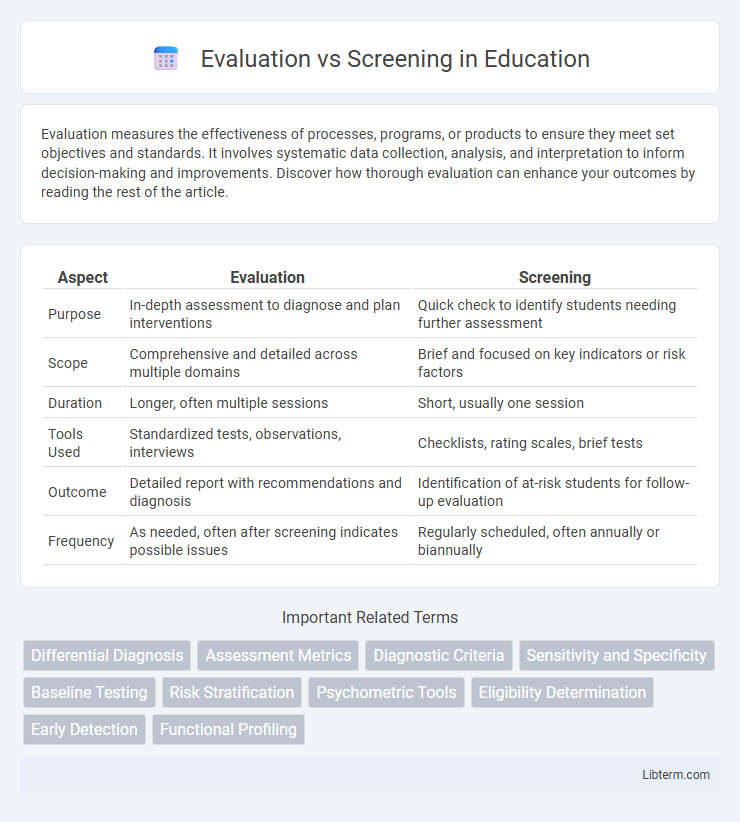Evaluation measures the effectiveness of processes, programs, or products to ensure they meet set objectives and standards. It involves systematic data collection, analysis, and interpretation to inform decision-making and improvements. Discover how thorough evaluation can enhance your outcomes by reading the rest of the article.
Table of Comparison
| Aspect | Evaluation | Screening |
|---|---|---|
| Purpose | In-depth assessment to diagnose and plan interventions | Quick check to identify students needing further assessment |
| Scope | Comprehensive and detailed across multiple domains | Brief and focused on key indicators or risk factors |
| Duration | Longer, often multiple sessions | Short, usually one session |
| Tools Used | Standardized tests, observations, interviews | Checklists, rating scales, brief tests |
| Outcome | Detailed report with recommendations and diagnosis | Identification of at-risk students for follow-up evaluation |
| Frequency | As needed, often after screening indicates possible issues | Regularly scheduled, often annually or biannually |
Introduction to Evaluation and Screening
Evaluation involves a comprehensive process of assessing an individual's abilities, skills, and needs using standardized tests and observational methods to inform diagnosis or intervention planning. Screening serves as a preliminary step designed to quickly identify individuals who may require further in-depth evaluation by highlighting potential areas of concern or risk. Both processes are critical in educational and healthcare settings to ensure timely and appropriate support tailored to individual needs.
Defining Evaluation
Evaluation is a comprehensive process that systematically gathers detailed information to assess an individual's abilities, needs, and progress through various standardized tests and observations. It provides in-depth insights to guide diagnosis, treatment planning, or educational placement, differentiating it from screening, which is a preliminary and quick check. The primary purpose of evaluation is to identify specific challenges and strengths to develop personalized intervention strategies.
Defining Screening
Screening is a preventative healthcare process aimed at early identification of potential health issues or risk factors in asymptomatic populations. It involves the use of standardized tests or assessments to detect diseases such as cancer, diabetes, or hypertension before symptoms appear. Effective screening programs are designed to maximize sensitivity and specificity to reduce false positives and negatives, enabling timely intervention and improved health outcomes.
Key Differences Between Evaluation and Screening
Evaluation involves a comprehensive, in-depth assessment using standardized tools to diagnose or understand complex conditions, while screening is a preliminary process designed to quickly identify individuals who may require further evaluation. Evaluations provide detailed data and insights for treatment planning, whereas screenings serve as a broad filter to detect potential issues early in large populations. The key difference lies in the scope, purpose, and depth: screening is brief and general, evaluation is thorough and specific.
Purposes and Objectives
Evaluation aims to comprehensively assess an individual's strengths, weaknesses, and developmental needs to guide diagnosis and intervention planning. Screening focuses on quickly identifying individuals at risk or in need of further evaluation, enabling early detection and referral. The primary objective of evaluation is detailed understanding for tailored support, while screening serves as an initial filter to prioritize resources efficiently.
Methods and Tools Used
Evaluation uses comprehensive methods such as standardized assessments, diagnostic interviews, and observational techniques to obtain an in-depth understanding of an individual's abilities and challenges. Screening employs brief, efficient tools like questionnaires, checklists, and quick symptom checkers designed to identify risk factors or early signs of a condition. Both processes rely on validated instruments, but evaluation emphasizes detailed, multi-dimensional analysis while screening focuses on rapid identification and referral decisions.
When to Use Evaluation vs Screening
Screening is used as a preliminary step to identify individuals who may require further assessment, typically applied in large populations for early detection of potential issues. Evaluation is conducted after screening when a detailed and comprehensive analysis is necessary to diagnose, determine severity, or develop intervention plans. Choosing between screening and evaluation depends on resources, purpose, and the need for accuracy in identifying specific conditions or risks.
Benefits of Each Approach
Evaluation provides a comprehensive assessment identifying specific needs, strengths, and challenges, enabling tailored interventions and informed decision-making. Screening offers a quick, cost-effective method to detect potential issues early, allowing for prompt referrals and preventive actions. Each approach serves unique benefits, with evaluation delivering in-depth insights and screening facilitating broad population monitoring.
Common Challenges and Limitations
Evaluation and screening processes often face challenges such as limited time and resource constraints, leading to incomplete data collection and potential inaccuracies. Common limitations include variability in interpretation, lack of standardized protocols, and potential bias influenced by evaluator experience or test conditions. These factors can reduce reliability and affect the overall effectiveness of both evaluation and screening outcomes.
Choosing the Right Approach for Your Needs
Evaluation involves a comprehensive, in-depth analysis to understand specific challenges or conditions, typically used in clinical or educational settings to inform diagnosis and intervention. Screening is a preliminary process designed to quickly identify individuals who may require further evaluation, often utilizing brief, standardized tools to detect potential issues early. Choosing the right approach depends on the goals, whether it is early detection through screening or detailed understanding through evaluation to tailor appropriate support or treatment plans.
Evaluation Infographic

 libterm.com
libterm.com